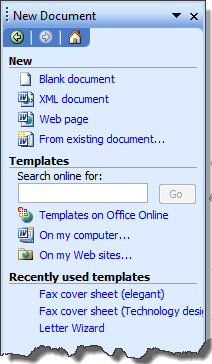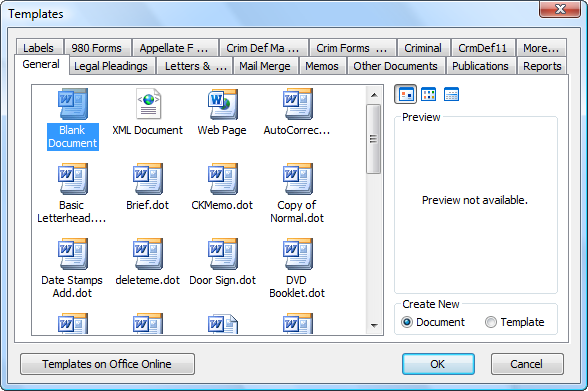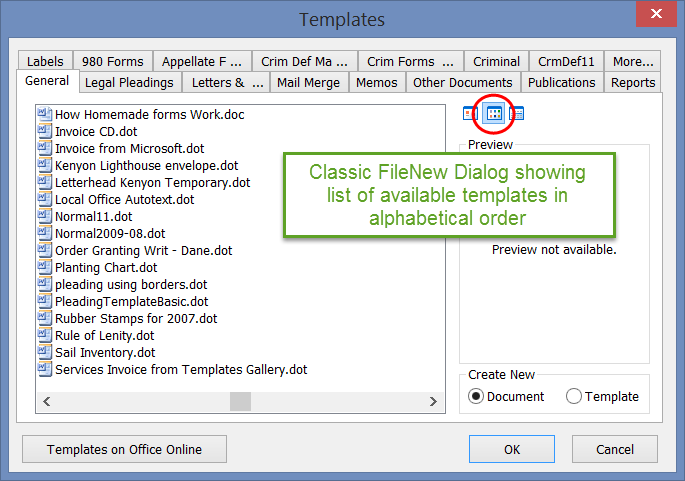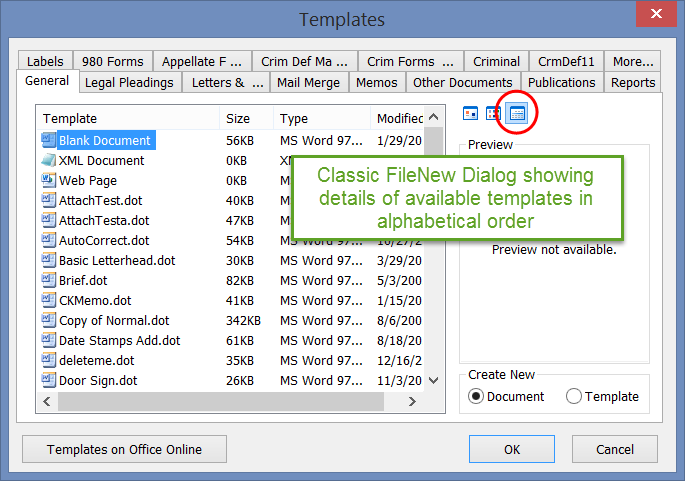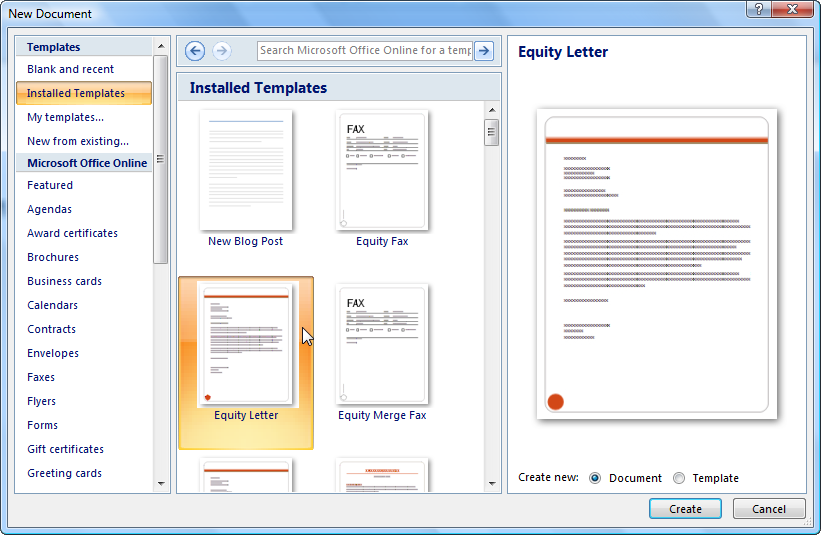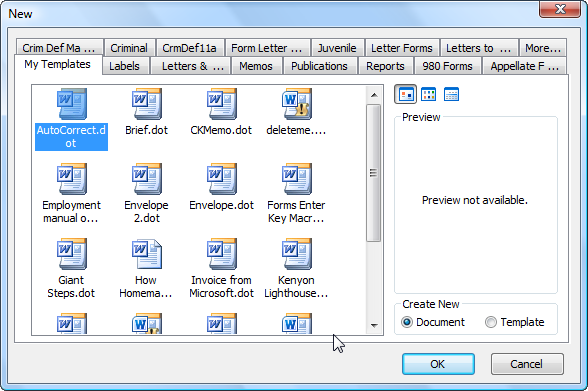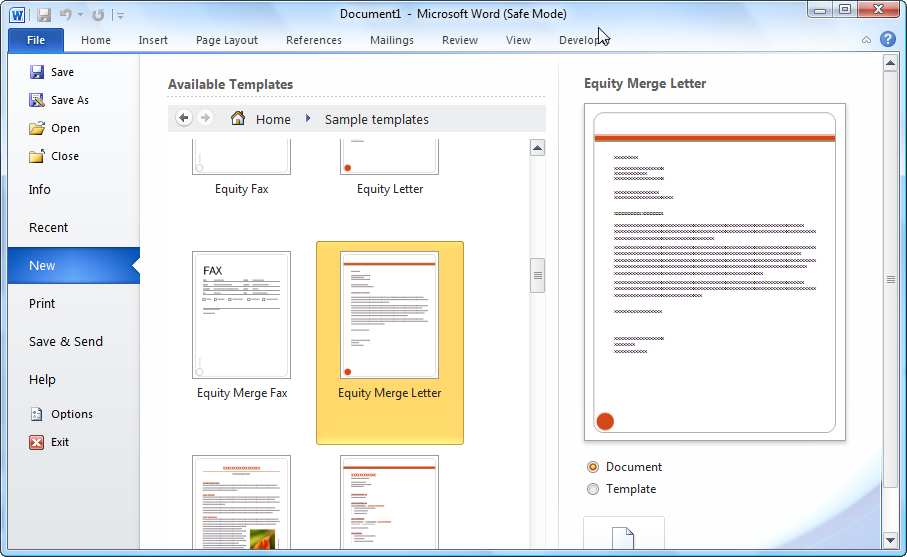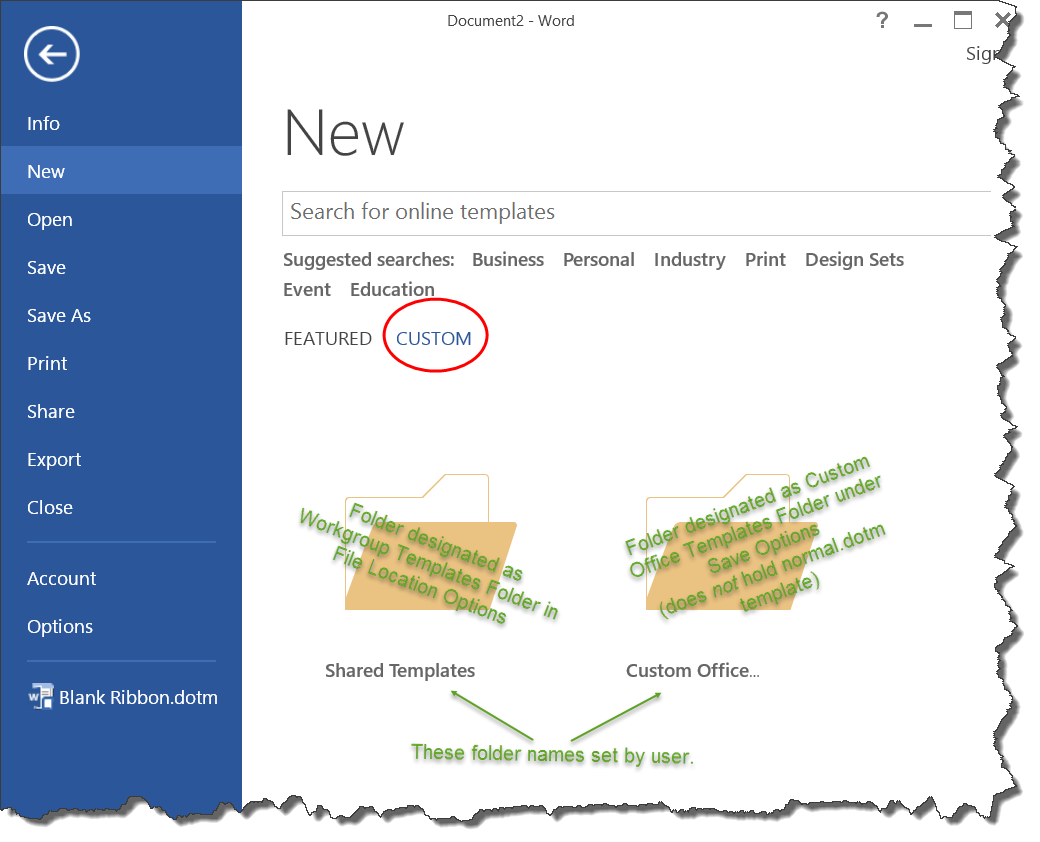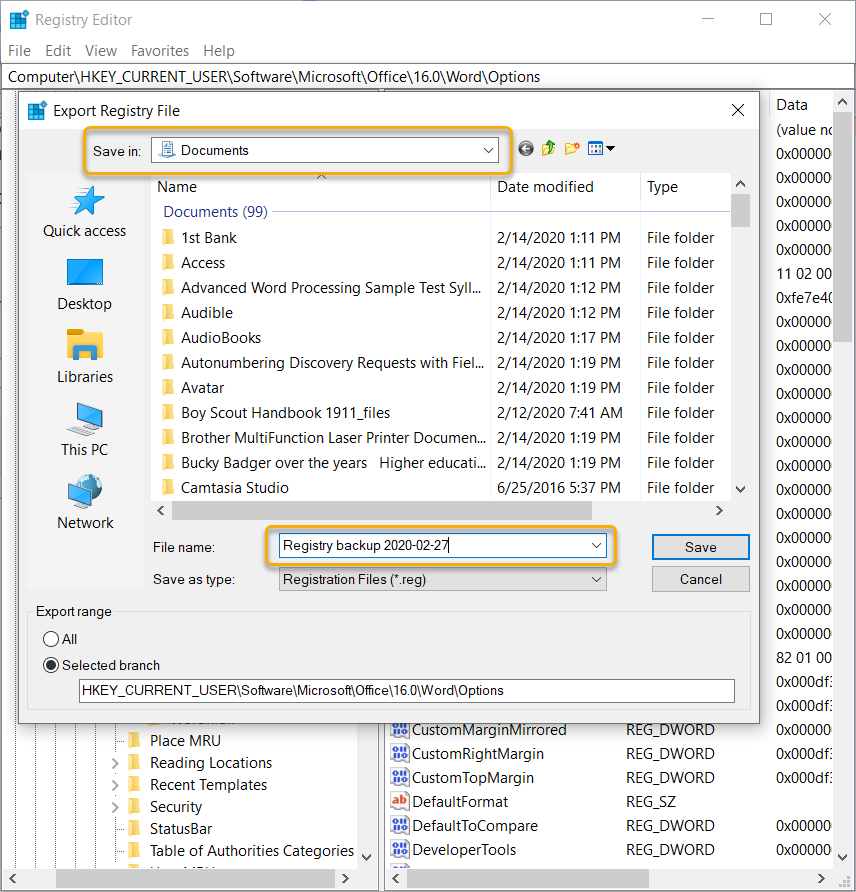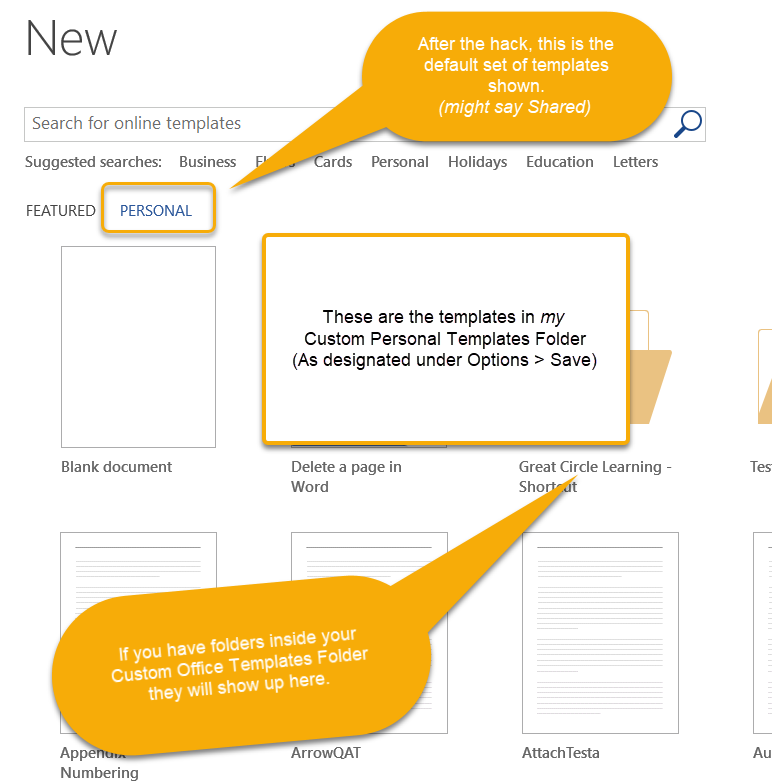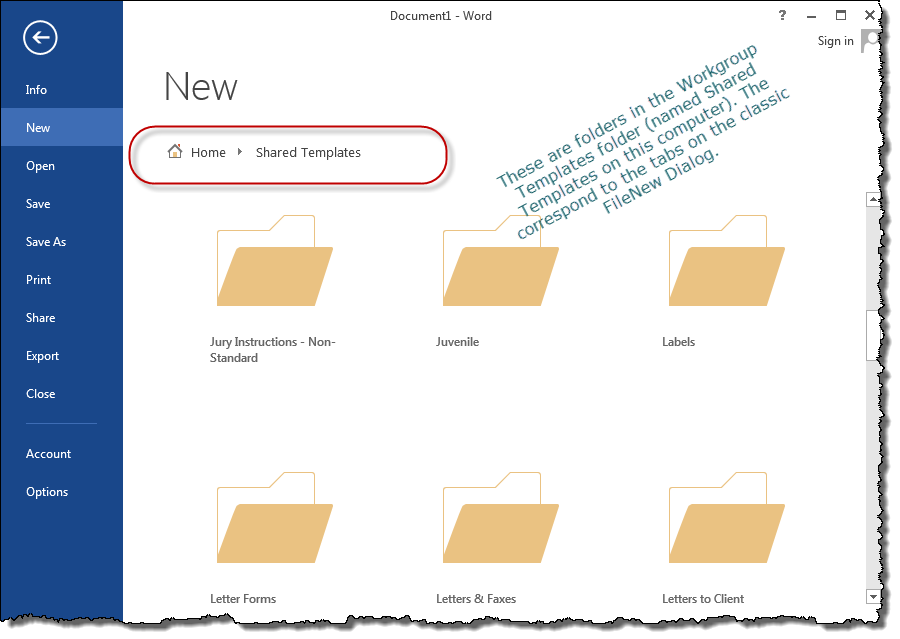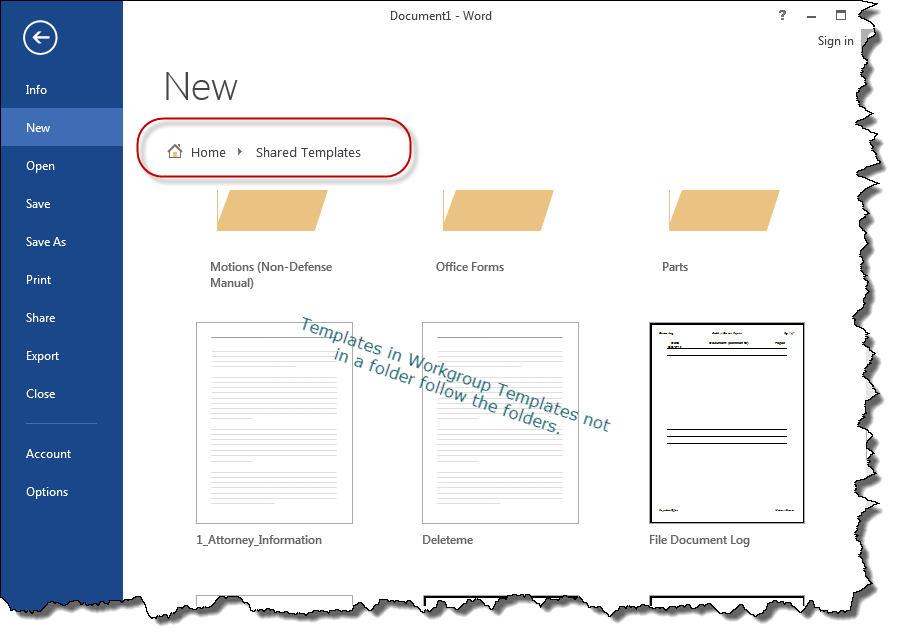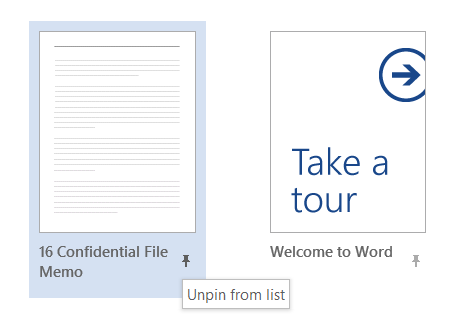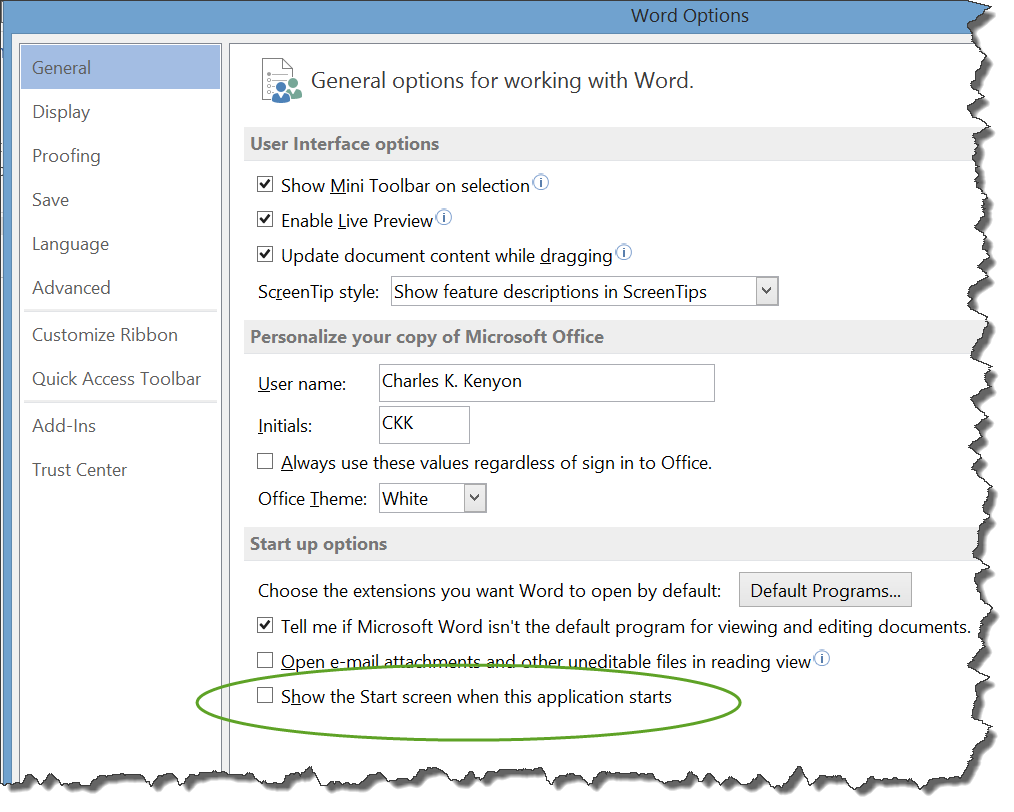File New in Microsoft Word - Access to User and Workgroup Templates - Registry Hackby Charles Kyle Kenyon, Esq. There are no promises that this chapter is of the same quality or depth as the other chapters of this guide. That is because it was written by a single author not working with Microsoft and not subject to peer review. Last updated Friday 12 September 2025. Comments are welcome.
Introduction. This could be a part of the chapter on
File New Variations
but would bloat that chapter. This chapter is for Word for Windows Versions 2013 and later. First, why?
Macintosh versions of Word (2004, 2008, 2011, 2014, 2016, 2019, 2021, 2024 / 365) are not covered here although they may be similar to the Windows versions. I have not used Word on the Mac since Version 6.0 and do not have the experience to write helpfully about those versions. Things Covered In This Web PageThis page takes a look at: Additional Written and Web Resources
Creating a New Document Based on a TemplateWord uses the standard Windows keyboard shortcut (Ctrl+N) to create a new document. This is actually a new document based on the Normal template (Normal.dot or Normal.dotm). This should be a blank document without text. However, it is rare that we want to begin documents from scratch. Ordinarily what we want to do now is similar to something we have done in the past. For that we can save a lot of time by using a template. There are many templates distributed with Word and many available online. Those who use Word extensively, tend to build their own set of templates, often based on modifications of the generic ones. This is good practice. The FileNew dialog gives access to these templates. That access has changed through the versions of Word. Starting Point - Word 97-2000In Word 97-2000, when you selected "New" under the File menu you saw a dialog that looked something like this:
In this article, I refer to this as the FileNew dialog. As is explained in the Templates chapter, this dialog gives quick access to templates on your computer in certain designated locations. It includes templates distributed with Word (some built into the program), those in the User Templates folder and those in the Workgroup Templates folder and their subfolders. It does not give access to templates that may be stored elsewhere on your computer or on the Office site. Every installation of Word will have a User Templates folder which has a default location but which can be designated by the user. A separate folder (local or network) can be designated by the user as the Workgroup Templates folder. Word does not create such a folder upon installation, it must be created by the user. I have found using these two folders to store any templates for daily work to be beneficial and this FileNew dialog to be a quick way to use templates that have been developed or modified locally. Over time, there was a great push for new users to have access to templates they can use immediately without developing their own. This has resulted in changes to what shows up with File => New making the basic FileNew dialog shown above harder to find. This chapter is about those changes and how to use them but still reach and use the FileNew dialog.
Word 2002-2003 and the Introduction of the New File PaneSelecting New from File in Word 2002-2003 opens a Task Pane on the right side of your Word window something like the following:
Selecting "General Templates" (Word 2002) or "On my computer" (Word 2003) gets you the FileNew dialog:
The Task Pane also has the option to look at Templates on Microsoft.com (Word 2002) Office Online (Word 2003) or on My web sites. The Word 2003 new file dialog itself has a button to go to Office Online. It is possible in all versions from Word 97 on to also look at lists of templates including details in this dialog.
In Word 97-2003, the FileNew dialog includes (1) installed templates, (2) user templates, and (3) workgroup templates. Here's how to get to this dialog without going through the New File Pane.
Word 2007 - the Ribbon Interface and the Emphasis on Office Online TemplatesWord 2007 brought us the Ribbon Interface. This was part of a drastic makeover of Office and eventually Windows and many other programs (not produced by Microsoft). The idea is to make many more commands accessible to the novice. As a part of this, the Office Online templates were moved toward center stage. The File menu disappeared, replaced for some purposes with the orange Office Button. Going to Office Button => New starts with Blank and recent templates but provides other choices.
The long list of categories for templates looks like the tabs in the FileNew dialog but refers to Office Online templates, not those installed on the computer with Word or placed there by the user. Installed templates refers to templates from Microsoft, not user or workgroup templates. These "Installed" templates are actually built into the program rather than separate template files on the computer.
Microsoft Office Online gives a bevy of templates divided into categories (searches on Office Online). What we are interested in here, though, is templates created or modified locally. If stored in the User Templates Folder or the Workgroup Templates folder, these are accessed using "My templates..."
This brings us our traditional or classic FileNew dialog (with no button for Office Online). Beginning with Word 2007 this dialog no longer includes the "Installed" templates but simply those found in the User Templates Folder and the Workgroup Templates Folder. For me, this is fine. If you want to be able to get to this dialog with a keyboard shortcut or an icon on the QAT, skip to that section.
Word 2010 Starts With Graphic Office Online IconsWord 2010 returned something that looks like a File menu - the blue File Button which takes us to the "backstage" of the document. When New is selected there, we get a graphic emphasis on Office Online templates right away.
or - closer up -
The categories with icons shown in the predominate bottom part of the screen are for Office Online templates, not built-in templates, not user or workgroup templates. These look like the tabs in the FileNew dialog but are not. Again, these give a search result (Bing) for templates in that category on Office Online. The "Sample templates" in the Home part of the window are those built into the program -- the same as Word 2007's "Installed Templates."
Again, these are built into the program, not separate files on the computer. It is possible, using XML, to add your own custom templates to the featured templates. Your author has not done this, but it is discussed in Deploy Custom Templates. If "My templates" is selected we get (surprise!):
Again, this dialog is a combination of the templates in the User Templates folder and the Workgroup Templates folder under tabs. The tabs are representations of subfolders in those folders. See the Templates Chapter for more on that relationship and the folder organization. If you want easier access to FileNew Dialog in Word 2010, you can skip ahead to that section to see how to get a keyboard shortcut, an Icon on the QAT or even a button on the Ribbon to take you there. Word 2013 Changes Things Up AgainWord 2013-24 changed the default location of custom user templates from a hidden Templates folder to one called "Custom Office Templates" stored in the user's Documents folder. Again, this is a default. Word 2013 tries to store any document you save as a template to the this templates folder (returning to earlier behavior). The normal.dotm file is still saved in the User Templates Folder. See below for more on this distinction. When you choose File > New, Word 2013-24 does not display the FileNew dialog or even look like it gives you a choice of your custom templates! It starts you out with icons of Office Online Featured templates.
Note: If when you Start Word 2013-24 you are seeing something like this when you expect or want to see a blank document, see Word 2013-24 Startup Screen. It is possible, using XML, to add your own custom templates to the featured templates. Your author has not done this, but it is discussed in Deploy Custom Templates. Hidden in the clutter of that crisp-looking screen next to "Featured" is the word "Personal" or "Custom" or "Shared." My thanks to this Wiki article for the explanation for the variations in what shows up.
Each of these words look like text, but they are buttons that you click on to get to another screen.
The folder names shown above were set by the user. The default location for user templates changed in Word 2013 from "Templates" to "Custom Office Templates." The old template folder (which contains the normal template) does not show up on this dialog. Workgroup Templates have no default name or location in any version of Word.
Registry Hack:
Figure 2013-3. If you click on one of the folders, you get to see icons for its contents, beginning with the folders.
If you click on one of those internal folders, you get to icons for its contents.
In the classic dialog there would be a tab for "Appellate Forms CK." Clicking on that tab would get you to those templates, shown as (smaller) icons or as a list. The Classic File New dialog (which you would reach by clicking on "On My Computer" or "My Templates" in earlier versions is not available in Word 2013-24 without modification. That dialog allows direct manipulation of templates (i.e. copy or delete) as in Windows and lets you show lists of template names rather than icons. It combines the templates in the user templates folder and those in the workgroup templates folder. It does not show any templates in the Custom Office Templates folder unless that folder is set to also be the user templates folder or the workgroup templates folder. You can easily add access to the classic FileNew dialog to your Word 2013-24. Advantages of the Word 2013-24 method:
When you mouse-over a template, the pin icon (pin pointed horizontally) will appear. If you click on that pin icon, it will rotate and the template will appear on the initial File New dialog. Word 2013-24 installs with the "Take a Tour" template pinned. Clicking on the pin of a template already pinned, will rotate the pin back to horizontal and unpin the template. If you hesitate in clicking on the pin/unpin icon, you'll get a tooltip as shown.
None of the proposed 2013-24 modifications preclude using the native Word 2013-24 method and screens. Word Start Screen adds another wrinkle.One more wrinkle is that Word 2013-24 comes with a new Startup (splash) screen that makes things even more confusing. You can get rid of it in Word Options.
The Distinction between the User Templates Folder and the Default Personal Templates Location in Word 2013/365 and later.Word 2007-2010 save newly created templates where documents are saved, by default. This is not a good place to be saving templates. Earlier versions saved them in the User Templates folder, by default. Word 2013/365 introduced the "Default Personal Templates Location." By default this is a separate folder called Custom Office Templates in the documents folder. It holds templates created or saved by the user but does not hold the normal.dotm template. The user can change the location of the Default Personal Templates folder under the File > Options > Save dialog. Again, this folder is distinct from the User Templates folder set under File > Options > Advanced > File Locations. That folder contains the normal.dotm template.
This (Default Personal Templates folder) is the location Word will look for templates under the File > New dialog as Personal. It will NOT look at the User Templates folder unless that folder is the same folder! Unless this folder is also designated as the User Templates folder, it will not contain the functioning normal.dotm template. The User Templates folder is a roaming location by default and can be set under File > Options > Advanced > File Locations. It will contain the normal.dotm template and will show up in the classic FileNew dialog. I recommend that most users designate the "user templates folder" and the "default personal templates" folder to be the same location. See also this discussion on the Word Answers forum.
Getting to the classic FileNew dialog without all the intermediate stepsSee FileNew Variations in Microsoft Word Keyboard Modifications to Word 2013-24 Saved in Normal.dotm by DefaultYou will see an option for storage location option on each of the Customize dialogs. The modifications made to keyboard shortcuts are stored in the normal.dotm template by default. Those to the QAT are stored in the Word.OfficeUI file. These are the easy place to keep these and you may want to do so, but you should be aware that you are making a choice. Instead, you can save them in your own template(s). If such a template is placed in the Word Startup Folder, the modifications will apply in all documents. Taking the template(s) out of that folder removes the customizations from Word. This is the easiest way to make customizations you may want to remove or may want to share with others. (Normal.dotm should never be a shared file.) Such a resource template is called a Global Template. See Modifying the QAT for more on QAT storage locations. Modifications made to the Ribbon through the Interface are stored in a file called Word15.CustomUI. This file is not something you should transfer to another user or computer. Word does allow you to export and import ribbon customizatons, but such a import is an all-or-nothing proposition and wipes any existing customizations. If you want Ribbon customizations only to certain templates or want to be able to easily transfer ribbon customizations without wiping out existing ones, explore XML modification. Customize the Ribbon (It doesn't take rocket science) Here is a free Add-In you can download contains such a global template. Jay Freedman has a different Add-In that uses a custom dialog box instead of the classic dialog box. It is available as a free download from his MacroZone site. The name of the download is NewDocUserForm.zip.
Copyright (c) 2000, 2014-2025 Charles Kyle Kenyon, Madison, Wisconsin, USA All rights reserved. Please do not copy this without express permission. |
|||||||||||||||||||||||||||||||
|
|
 Copyright 2000, Microsoft Corporation.
Copyright 2000, Microsoft Corporation.
Copyright 2000-2002, 2004-2006, 2010-2025
Charles
Kyle Kenyon
See information about copy permission.
Search Intermediate Users Guide to Microsoft Word Using Google My office page as a Madison, Wisconsin Criminal Defense Lawyer.
Original Legal Users Guide to Microsoft Word 2002 - Documents in Zip Format
A note about link exchanges. This site does not participate in link exchanges to build web presence. If you have a link that you think would be of use to people reading this page, please send it to the webmaster with the url of the page where you think it should appear and it will be considered. Your placing a link to this site will not affect the decision on whether to add your link, though.
.png)



